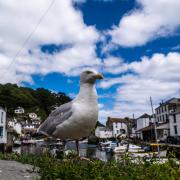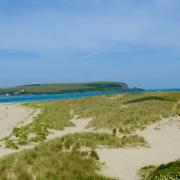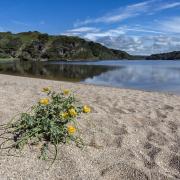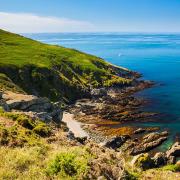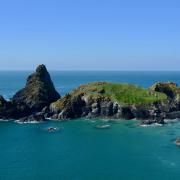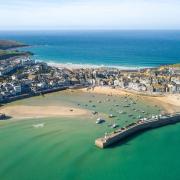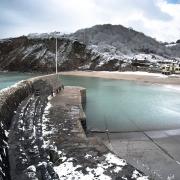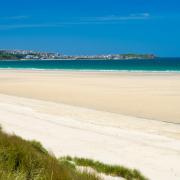Outdoor swimming is increasing as more of us take to the shores and lakes for a more natural water experience
Most of us are no stranger to standing on the shoreline, toes wiggling in the sand as the waves advance and retreat, lapping around our ankles and enveloping them in the cold. For many, this bitter caress is enough, but for an increasing number of others it is just the beginning of the experience of a wild swim. The number of people flocking to the shore, to satiate their primal calling to the water like animals heading to the watering hole, has increased greatly during the pandemic. But why is it that more people are taking regular trips to the coast in all weathers to immerse themselves in the cold? And what exactly does wild swimming entail?

Wild swimming is the act of swimming outdoors in a place where nature is all around you. Whilst there is some variation in definition – with some including only natural bodies of water, and others including man-made locations such as tidal pools and lidos too – the underlying premise is the same; you are surrounded by nature and exposed to the elements. In Cornwall and the UK, wild swimming is often classed as cold water swimming, which entails immersing yourself in temperatures of 16 degrees celsius and below. The temperature range of the ocean in Cornwall tends to be from around 9 degrees in February when the water is at its coldest, to 20 degrees in October at its warmest.

With more than 300 beaches and an excellent choice of both salt and fresh water swimming locations, as well as spectacular views to compliment them, it’s unsurprising that Cornwall’s already populous wild swimming community is rapidly expanding. Short conversations with wild swimmers, both seasoned and new, reveal that it is no coincidence that numbers have increased during the pandemic. It becomes clear that it is a means for many to find connection and to practice the art of relinquishing control during a time of isolation and unpredictability. “It’s invigorating” I hear them say, and “it makes me braver” others reveal.

Another common theme is its healing powers, both psychological and physical. Many of those getting in for regular alfresco dips claim it is a tonic for the mind, providing them with an ability to connect to the present moment, whilst washing away the anxieties and stresses of their routine on land. Although research into these benefits are often anecdotal, they have been reported for centuries. Florence Nightingale and Charles Darwin were both advocates of cold water immersion to strengthen both the mental and physical state and Roger Deakin documents the transformative power of wild swimming in his classic novel Waterlog. He describes that when entering the water “something like metamorphosis happens” and reports that the sense of being in the present moment is “overwhelming”. More recently, NASA studies have shown that a twelve week course of cold water swimming leads to ‘cold adaptation’, boosting the immune system, whilst relieving symptoms of depression, bringing down blood pressure and lowering cholesterol.

There is often a sense of trepidation when considering entering the water for a wild swim, but this is all part of the experience. It is natural to encounter fear when submerging yourself in the cold and particularly when swimming out of your depth, but by being responsible and treating the ocean with respect the positives are insurmountable. A huge part of the draw of wild swimming and the reason people keep going back for more is the natural release of endorphins. The elated mood and heightened senses experienced when conquering your fears and immersing yourself in another world are often described as awe-inspiring. You are a different person when leaving the water, with a well-deserved sense of achievement and bravery.

Beyond the physical and mental health benefits it offers, wild swimming is also an exciting way to experience the natural world. There is something remarkable about a seal popping its head up just metres away from you, and spotting a cormorant at eye level as it prepares to dive for its catch enables you to see the world from a different perspective. Perhaps one of the most appealing things about wild swimming is that it is inclusive. Whilst there are plenty of opportunities to take part in competitive open water swimming, for many it is solely about experiencing the thrill of the ocean. It is an activity undertaken by people of all backgrounds across a staggering range of ages, all of whom are connected in their desire for a cathartic outdoor experience and to be immersed in nature.

Most wild swimming in Cornwall is ocean orientated, though there are also a number of freshwater locations to be enjoyed. Cornwall is unique in its impressive geological structures and abundance of maritime history to be encompassed by whilst swimming. From the harsh cascading cliff faces of Lands End to the calm shorelines of the Helford interspersed with subtropical flora, each location offers a different experience. Some locations can only be accessed at low tide, such as tidal pools and certain beaches, whilst others offer more consistency. Part of the thrill is that you are beholden to the patterns of nature, which are unpredictable. This makes it all the more rewarding when the conditions are perfect. You can also expect to see a wide range of wildlife both on your way to locations and as you participate in wild swimming. For example, it is not uncommon to see the endangered grey seal and a wide range of bird species throughout the year.

How to get involved
There are a number of wild swimming groups across the county, which welcome new members all year round. Alternatively, open water swimming lessons are an option for those wishing to cover longer distances. For more information on wild swimming in Cornwall, including where to swim, how to swim and safety information visit wildswimmingcornwall.co.uk. The RNLI website also includes important safety information. Remember to always swim with a companion and if you’re new to wild swimming it’s best to stick to lifeguarded beaches and swim within the red and yellow flags.
This article first appeared in Cornwall Life. See our latest subscription offers here





